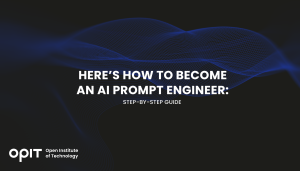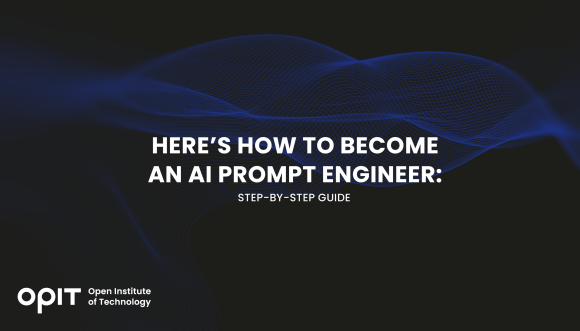

Artificial Intelligence (AI) is the talk of the town (or the globe). It is currently leading the charge in tech advancements in almost every sector, from healthcare to customer service. The advancement of AI has also brought new roles along with it, chief among them that of an AI prompt engineer—a career at the confluence of AI innovation and human creativity. This guide will show you how to join this cutting-edge field, where technical prowess meets linguistic flair and psychological insight.
Here’s how to become an AI prompt engineer.
What Is an AI Prompt Engineer?
AI prompt engineers translate and bridge the gap between human curiosity and AI’s massive knowledge base. They construct the behind-the-scenes questions or “prompts” that ask AI systems in a way that the machine’s response gives just the right result.
Imagine asking an AI about the best way to make a pizza, and instead of getting a recipe, you end up with a history lesson on tomatoes. You don’t have to be precise with your imagination because AI prompt engineers to step up, tweak, and fine-tune the prompts to lead the AI toward understanding the question.
These engineers also help interpret the AI’s responses and refine those prompts based on accuracy and relevance. They teach it how to understand not just words but the intent behind them. It’s what makes AI conversations feel more natural and less like you’re talking to a textbook.
AI prompt engineers are at the forefront of bridging the gap between human intentions and AI’s capabilities. They observe and train the AI models to grasp and respond to human languages more effectively.
Essential Skills and Qualifications
For this role, one must cultivate a blend of technical, creative, and analytical skills. The following are essential for any aspiring AI prompt engineer:
- Python. This lingua franca of AI development is necessary for any AI prompt engineer. You should have a solid grasp of this language for coding and for leveraging AI frameworks and libraries for developing and refining AI models.
- Natural Language Processing (NLP). As a merge between linguistics and computer science, it’s the heart of what makes AI systems understand and generate human language. Knowledge of NLP principles and technologies enables AI prompt engineers to make prompts that make sense to the AI.
- Creative touch. While you can’t necessarily learn the skill, it’s still fairly essential and leads to prompts that are clear to the AI and engaging or meaningful to humans. You must find novel ways to communicate with AI to achieve sought-after outcomes.
- Machine learning. You will also need a fundamental understanding of this field of study. Engineers use it to fine-tune AI models and improve their responsiveness and accuracy using feedback loops from real-world interactions.
AI prompt engineer is a very new job title, so it isn’t quite yet a distinct traditional academic path. Still, many paths can lead to this career.
- Computer science gives you a broad foundation in programming, algorithms, and data structures, technical skills necessary for AI development.
- Linguistics may not seem like a major to lead into a tech job. Still, it gives insights into the structure and function of language for understanding and improving AI’s language processing.
- Cognitive science bridges the gap between human psychology and computer science. It can show you how a machine can mimic (or fail at mimicking) human thinking.
- AI and machine learning programs, as a whole, focus directly on the technologies behind AI, which are the foundation for an AI prompt engineer.
Path to Becoming an AI Prompt Engineer
So, how to become an AI prompt engineer, then? Now that you understand what skills you need and what degrees might be the best, let’s see how to get there.
- Pursue a bachelor’s or master’s degree in fields that lay the groundwork for a career in AI, like computer science, linguistics, cognitive science, or AI and machine learning. You’ll get the theoretical basics and technical skills to get the human and computational parts of AI prompt engineering.
- Look for internships where you can work on actual AI projects. Try personal projects or contribute to open-source AI. Such projects can be related to anything you enjoy. Doing so is fun and lets you experiment and innovate with AI technologies. Moreover, others, including possible employers, will get an idea about your skills.
- Never stop learning. Take part in workshops, enroll in online courses, and get as many certificates in AI, NLP, and machine learning as you can.
- Take part in the AI community through forums, social media groups, and conferences. When you’re a part of a group effort, you get to learn and grow along with the community and get your name out.
- Take time to reflect on your learning and projects. Be open to exploring new areas of AI that interest you, and don’t be afraid to change your focus as you discover what excites you the most about AI prompt engineering and what might miss the mark for you.
OPIT’s Programs in AI and Machine Learning
OPIT’s educational program lineup offers several pathways to becoming an AI prompt engineer—the MSc in Responsible Artificial Intelligence, the BSc in Modern Computer Science, and the MSc in Data Science & AI. These degrees give you all the skills you need to tackle AI prompt battles and victories.
The heavy-duty content covers everything from the basics to the brain-bending advanced topics. Once you know the theory, you will also get the practice of project-based learning that takes you out of the classroom (figuratively, since you might still physically be in one). Hands-on learning segments plunge you into real-world AI development.
By the time you’re done, you will be theoretically proficient and have experience in applying AI in various scenarios, including the nuanced art of prompt engineering. For example, you might have to refine an AI’s ability to understand and generate human-like. Or, you might develop prompts that take an AI through complex ethical dilemmas.
Why Choose a Career as an AI Prompt Engineer
Being an AI prompt engineer takes you straight to the front lines of AI development, where every day brings a new challenge and a chance to shape the future of how humans and machines interact. It’s a career path with immense potential for growth, innovation, and creativity. This career is ideal for tech-inclined people who want to be pioneers, a part of the bleeding-edge technology before it becomes a necessary part of everyone’s workflow.
Be at the AI Frontlines
Now you know how to become an AI prompt engineer, so it’s time to get started on this exciting career path. Focus on relevant degree programs like computer science, linguistics, or AI, and keep an eye out for opportunities for more hands-on learning – whether it’s an internship or an open source project.
While you’re mapping out your career path, let OPIT be part of the journey with programs that will set you up for success in this field. Whether it’s a bachelor’s or master’s degree, you’ll receive a comprehensive education with relevant hands-on experience from experts in the field, poised to position any aspiring AI prompt engineer for success.
Related posts

Source:
- Agenda Digitale, published on November 25th, 2025
In recent years, the word ” sustainability ” has become a firm fixture in the corporate lexicon. However, simply “doing no harm” is no longer enough: the climate crisis , social inequalities , and the erosion of natural resources require a change of pace. This is where the net-positive paradigm comes in , a model that isn’t content to simply reduce negative impacts, but aims to generate more social and environmental value than is consumed.
This isn’t about philanthropy, nor is it about reputational makeovers: net-positive is a strategic approach that intertwines economics, technology, and corporate culture. Within this framework, digitalization becomes an essential lever, capable of enabling regenerative models through circular platforms and exponential technologies.
Blockchain, AI, and IoT: The Technological Triad of Regeneration
Blockchain, Artificial Intelligence, and the Internet of Things represent the technological triad that makes this paradigm shift possible. Each addresses a critical point in regeneration.
Blockchain guarantees the traceability of material flows and product life cycles, allowing a regenerated dress or a bottle collected at sea to tell their story in a transparent and verifiable way.
Artificial Intelligence optimizes recovery and redistribution chains, predicting supply and demand, reducing waste and improving the efficiency of circular processes .
Finally, IoT enables real-time monitoring, from sensors installed at recycling plants to sharing mobility platforms, returning granular data for quick, informed decisions.
These integrated technologies allow us to move beyond linear vision and enable systems in which value is continuously regenerated.
New business models: from product-as-a-service to incentive tokens
Digital regeneration is n’t limited to the technological dimension; it’s redefining business models. More and more companies are adopting product-as-a-service approaches , transforming goods into services: from technical clothing rentals to pay-per-use for industrial machinery. This approach reduces resource consumption and encourages modular design, designed for reuse.
At the same time, circular marketplaces create ecosystems where materials, components, and products find new life. No longer waste, but input for other production processes. The logic of scarcity is overturned in an economy of regenerated abundance.
To complete the picture, incentive tokens — digital tools that reward virtuous behavior, from collecting plastic from the sea to reusing used clothing — activate global communities and catalyze private capital for regeneration.
Measuring Impact: Integrated Metrics for Net-Positiveness
One of the main obstacles to the widespread adoption of net-positive models is the difficulty of measuring their impact. Traditional profit-focused accounting systems are not enough. They need to be combined with integrated metrics that combine ESG and ROI, such as impact-weighted accounting or innovative indicators like lifetime carbon savings.
In this way, companies can validate the scalability of their models and attract investors who are increasingly attentive to financial returns that go hand in hand with social and environmental returns.
Case studies: RePlanet Energy, RIFO, and Ogyre
Concrete examples demonstrate how the combination of circular platforms and exponential technologies can generate real value. RePlanet Energy has defined its Massive Transformative Purpose as “Enabling Regeneration” and is now providing sustainable energy to Nigerian schools and hospitals, thanks in part to transparent blockchain-based supply chains and the active contribution of employees. RIFO, a Tuscan circular fashion brand, regenerates textile waste into new clothing, supporting local artisans and promoting workplace inclusion, with transparency in the production process as a distinctive feature and driver of loyalty. Ogyre incentivizes fishermen to collect plastic during their fishing trips; the recovered material is digitally tracked and transformed into new products, while the global community participates through tokens and environmental compensation programs.
These cases demonstrate how regeneration and profitability are not contradictory, but can actually feed off each other, strengthening the competitiveness of businesses.
From Net Zero to Net Positive: The Role of Massive Transformative Purpose
The crucial point lies in the distinction between sustainability and regeneration. The former aims for net zero, that is, reducing the impact until it is completely neutralized. The latter goes further, aiming for a net positive, capable of giving back more than it consumes.
This shift in perspective requires a strong Massive Transformative Purpose: an inspiring and shared goal that guides strategic choices, preventing technology from becoming a sterile end. Without this level of intentionality, even the most advanced tools risk turning into gadgets with no impact.
Regenerating business also means regenerating skills to train a new generation of professionals capable not only of using technologies but also of directing them towards regenerative business models. From this perspective, training becomes the first step in a transformation that is simultaneously cultural, economic, and social.
The Regenerative Future: Technology, Skills, and Shared Value
Digital regeneration is not an abstract concept, but a concrete practice already being tested by companies in Europe and around the world. It’s an opportunity for businesses to redefine their role, moving from mere economic operators to drivers of net-positive value for society and the environment.
The combination of blockchain, AI, and IoT with circular product-as-a-service models, marketplaces, and incentive tokens can enable scalable and sustainable regenerative ecosystems. The future of business isn’t just measured in terms of margins, but in the ability to leave the world better than we found it.

Source:
- Raconteur, published on November 06th, 2025
Many firms have conducted successful Artificial Intelligence (AI) pilot projects, but scaling them across departments and workflows remains a challenge. Inference costs, data silos, talent gaps and poor alignment with business strategy are just some of the issues that leave organisations trapped in pilot purgatory. This inability to scale successful experiments means AI’s potential for improving enterprise efficiency, decision-making and innovation isn’t fully realised. So what’s the solution?
Although it’s not a magic bullet, an AI operating model is really the foundation for scaling pilot projects up to enterprise-wide deployments. Essentially it’s a structured framework that defines how the organisation develops, deploys and governs AI. By bringing together infrastructure, data, people, and governance in a flexible and secure way, it ensures that AI delivers value at scale while remaining ethical and compliant.
“A successful AI proof-of-concept is like building a single race car that can go fast,” says Professor Yu Xiong, chair of business analytics at the UK-based Surrey Business School. “An efficient AI technology operations model, however, is the entire system – the processes, tools, and team structures – for continuously manufacturing, maintaining, and safely operating an entire fleet of cars.”
But while the importance of this framework is clear, how should enterprises establish and embed it?
“It begins with a clear strategy that defines objectives, desired outcomes, and measurable success criteria, such as model performance, bias detection, and regulatory compliance metrics,” says Professor Azadeh Haratiannezhadi, co-founder of generative AI company Taktify and professor of generative AI in cybersecurity at OPIT – the Open Institute of Technology.
Platforms, tools and MLOps pipelines that enable models to be deployed, monitored and scaled in a safe and efficient way are also essential in practical terms.
“Tools and infrastructure must also be selected with transparency, cost, and governance in mind,” says Efrain Ruh, continental chief technology officer for Europe at Digitate. “Crucially, organisations need to continuously monitor the evolving AI landscape and adapt their models to new capabilities and market offerings.”
An open approach
The most effective AI operating models are also founded on openness, interoperability and modularity. Open source platforms and tools provide greater control over data, deployment environments and costs, for example. These characteristics can help enterprises to avoid vendor lock-in, successfully align AI to business culture and values, and embed it safely into cross-department workflows.
“Modularity and platformisation…avoids building isolated ‘silos’ for each project,” explains professor Xiong. “Instead, it provides a shared, reusable ‘AI platform’ that integrates toolchains for data preparation, model training, deployment, monitoring, and retraining. This drastically improves efficiency and reduces the cost of redundant work.”
A strong data strategy is equally vital for ensuring high-quality performance and reducing bias. Ideally, the AI operating model should be cloud and LLM agnostic too.
“This allows organisations to coordinate and orchestrate AI agents from various sources, whether that’s internal or 3rd party,” says Babak Hodjat, global chief technology officer of AI at Cognizant. “The interoperability also means businesses can adopt an agile iterative process for AI projects that is guided by measuring efficiency, productivity, and quality gains, while guaranteeing trust and safety are built into all elements of design and implementation.”
A robust AI operating model should feature clear objectives for compliance, security and data privacy, as well as accountability structures. Richard Corbridge, chief information officer of Segro, advises organisations to: “Start small with well-scoped pilots that solve real pain points, then bake in repeatable patterns, data contracts, test harnesses, explainability checks and rollback plans, so learning can be scaled without multiplying risk. If you don’t codify how models are approved, deployed, monitored and retired, you won’t get past pilot purgatory.”
Of course, technology alone can’t drive successful AI adoption at scale: the right skills and culture are also essential for embedding AI across the enterprise.
“Multidisciplinary teams that combine technical expertise in AI, security, and governance with deep business knowledge create a foundation for sustainable adoption,” says Professor Haratiannezhadi. “Ongoing training ensures staff acquire advanced AI skills while understanding associated risks and responsibilities.”
Ultimately, an AI operating model is the playbook that enables an enterprise to use AI responsibly and effectively at scale. By drawing together governance, technological infrastructure, cultural change and open collaboration, it supports the shift from isolated experiments to the kind of sustainable AI capability that can drive competitive advantage.
In other words, it’s the foundation for turning ambition into reality, and finally escaping pilot purgatory for good.
Have questions?
Visit our FAQ page or get in touch with us!
Write us at +39 335 576 0263
Get in touch at hello@opit.com
Talk to one of our Study Advisors
We are international
We can speak in:


